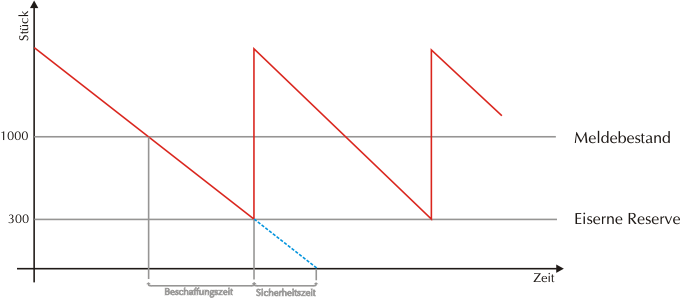Order point system
The order point system (also order point method) is a method for determining the time of order and order quantity in warehousing . The application of the order point system ensures that goods are always available in the warehouse when they are needed. The order point system is a part of the order policy . It is one of the consumption-oriented ordering processes that can be divided into an order point system and an order rhythm system.
properties
With the reorder point system, an order is triggered as soon as a previously defined reorder point (s) (= reorder point) is reached in the warehouse. This check is carried out after every stock exit. Since the order dates are not defined in advance, one speaks of variable order dates.
The level of the reorder level depends on the typical consumption up to the arrival of the ordered goods and a safety stock (= iron reserve) in the event of unusual delivery times or higher consumption. Ideally, the ordered goods arrive when the safety stock has just been reached in the warehouse.
Two different variants are used in the order point system.
- (s, q) policy or order point lot size policy : if the reorder level (s) is reached, a specified quantity (q) is ordered. The quantity q is usually calculated using the formula for the optimal order quantity (see below).
- (s, S) policy or order point warehouse level policy : if the reorder point (s) is reached, the warehouse is replenished to the target level (S).
Both policies require constant monitoring of the inventory, which is no longer a real problem with today's inventory management systems ( WWS , ERP , WMS ).
The fixed order quantity (q) is defined using Andler's formula for the optimal order quantity:
optimal order quantity =
or:
optimal order quantity =
The order quantity is calculated when using the (s, S) policy:
Order quantity = S - current stock level
Possibility to determine the reorder point
- Reorder level = 0
- Order only after it has been completely used up: Orders are placed when stocks are completely exhausted. This approach is only possible if the suppliers deliver very quickly and the shortage costs are very low.
- Reorder level = typical consumption until the delivery arrives
- The reorder point is chosen so large that with average consumption and average procurement time there is no gap in the supply. With this procedure, too, there is a risk of stock shortages. The daily demand during the procurement period can be above average and / or the average procurement period can be exceeded by the supplier.
- Reorder level = typical consumption until the delivery arrives + safety stock
- If a stock shortage has to be avoided in any case, the reorder stock is increased by a safety stock (e.g. for materials and finished-related parts without which production could not continue).
- BP = DV * BZ + SB
- BP = DV * (BZ + SZ)
BP = reorder point, order point; DV = average consumption per unit of time; BZ = procurement period; SB = safety stock, minimum stock; SZ = safety time
Security distance
Since exact data are not always available for calculating the reorder point, average values are assumed for the delivery time (= procurement time) and consumption. If delivery is delayed or consumption is higher, supply gaps occur.
The safety stock covers 3 uncertainties:
- Uncertainty of needs (determined need does not match daily need)
- Delivery uncertainty (target delivery time does not match the actual delivery time)
- Inventory uncertainty (book inventory and inventory do not match)
In every company, the safety stock can be determined individually at its own discretion and determined differently. Since the safety stock permanently causes storage costs, it should be as low as possible.
The diagram illustrates the process again graphically:
Compared to the ordering rhythm system
Since the stock level is compared with the reorder level every time a stock is left, short-term fluctuations in demand can be taken into account more quickly because no fixed order intervals are specified. Shortage costs can be reduced more easily if the reorder point is set accordingly high. The storage costs and thus an additional capital commitment depend on the level of the safety stock.
See also
Materials management , procurement logistics , order rhythm system
literature
- Werner Kern: Concise dictionary of the production economy. Stuttgart 1979, ISBN 3791080172
- Oskar Grün: Industrial materials management. In: Marcell Schweitzer (Ed.): Industriebetriebslehre. 2nd Edition. Munich 1994, pp. 447-568, ISBN 3-8006-1755-2


